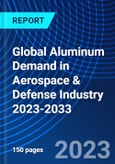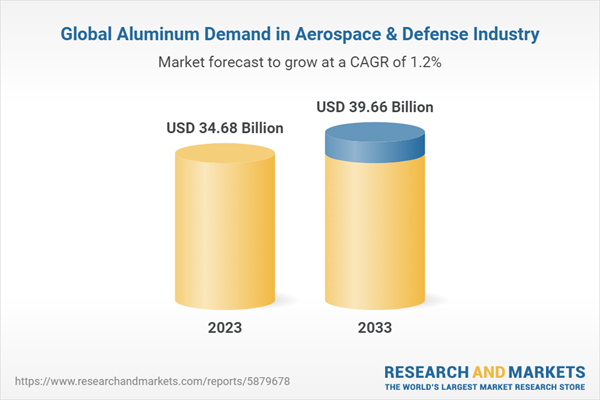The global market for aluminum components in the aerospace and defense industry has experienced remarkable growth and transformation over the years. Aluminum, renowned for its lightweight and versatile properties, has become a crucial material in manufacturing various aerospace and defense components. Its history in the aerospace sector dates back to the early 20th century, with the incorporation of aluminum alloys into aircraft design. Subsequent advancements in metallurgy and fabrication techniques have further improved aluminum's performance, solidifying its position as an indispensable material in the aerospace and defense sector.Despite the Ongoing Advancements in Material Science, Aluminum Maintains Its Significance and Widespread Usage
One of the significant advantages of aluminum components is their corrosion resistance. Aerospace and defense applications often subject components to challenging environmental conditions, including high humidity, temperature fluctuations, and exposure to various chemicals. Aluminum's natural oxide layer provides inherent corrosion resistance, ensuring the longevity and reliability of critical components under these harsh conditions. This property is particularly vital for maintaining the structural integrity of aircraft and spacecraft throughout their operational lifetimes.
Cost-effectiveness is another crucial factor contributing to the widespread use of aluminum components. Compared to other materials commonly used in aerospace and defense, such as titanium or composites, aluminum is more readily available and generally less expensive to produce. The lower production costs of aluminum translate into cost savings for manufacturers, allowing them to offer competitive pricing for their products.
The ease of fabrication is a key advantage of aluminum that appeals to aerospace and defense manufacturers. Aluminum alloys can be easily formed into various shapes, allowing the production of complex components required in modern aircraft and spacecraft designs. This flexibility in fabrication enables manufacturers to meet stringent design specifications and performance requirements while maintaining cost efficiency.
Sustainability and environmental considerations have become increasingly important in the aerospace and defense industry. Aluminum's recyclability is a compelling factor in this context. The recycling process for aluminum requires significantly less energy compared to primary production, making it an environmentally responsible choice. As sustainability practices gain prominence, the aerospace and defense industry is likely to emphasize the use of recycled aluminum to reduce its environmental impact.
The global market for aluminum components in the aerospace and defense industry can be segmented based on their applications. In the context of aircraft components, aluminum is extensively used in the construction of fuselages, wings, and landing gears. Fuselage panels and extrusions made from aluminum alloys provide the necessary structural strength while keeping weight at a minimum. Aluminum's excellent strength-to-weight ratio is also critical for wings, ensuring aerodynamic efficiency and stability during flight. Additionally, landing gears benefit from aluminum's ability to handle heavy loads without adding excessive weight to the aircraft.
Among the most prominent aluminum alloys used in aerospace is Aluminum Alloy 2024. This alloy, introduced in the 1930s, has since become a workhorse in the industry due to its high strength and fatigue resistance. Components like wings, fuselages, and structural elements often utilize 2024 aluminum alloy due to its ability to withstand the rigorous demands of aerospace applications. Another widely used alloy is Aluminum Alloy 7075, renowned for its exceptional strength and toughness. This alloy is favored for high-stress aerospace applications, particularly in critical components like aircraft wing spars, bulkheads, and landing gear parts. The use of 7075 ensures the necessary strength while keeping weight at a minimum, contributing to fuel efficiency and overall aircraft performance. Aluminum Alloy 6063, renowned for its extrudability and formability, is commonly used in aerospace applications for producing various extruded components. These include profiles, frames, and panels used in aircraft and spacecraft construction, where precise shaping and customization are essential. Aluminum Alloy 2014 is valued for its excellent machinability, making it an ideal choice for aerospace applications requiring precise machining. Components such as structural elements and fittings often use 2014 alloy, taking advantage of its machinability without compromising on strength or other mechanical properties. Aluminum Alloy 2124 is a variation of Alloy 2024 with added copper to improve fracture toughness. It is particularly valuable in aerospace applications where resistance to crack propagation is essential. This alloy is used in critical components where the prevention of crack growth is critical for the overall structural integrity of the aircraft. Among the newer developments in aluminum alloys is Aluminum Alloy 2025. Designed to offer improved mechanical properties and increased damage tolerance, Alloy 2025 is being explored for use in future aerospace applications. Its enhanced characteristics aim to meet the evolving demands of modern aerospace technology, providing designers with more options for optimizing component performance.
The defense industry is another significant contributor to global aluminum demand, where its applications range from military aircraft to naval vessels and ground-based equipment. Military aircraft, including fighter jets, transport planes, and unmanned aerial vehicles (UAVs), heavily rely on aluminum's high strength and structural integrity. The lightweight properties of aluminum allow military aircraft to carry more payload and fuel, enhancing their operational range and mission capabilities. Aluminum's role in the manufacturing of missiles, munitions, and other defense systems is also paramount, providing energy absorption and stability critical for their effective deployment.
In naval applications, aluminum plays a crucial role in constructing warships, naval vessels, and submarines. Its corrosion resistance is particularly advantageous in maritime environments, where vessels are exposed to harsh saltwater conditions. Additionally, aluminum's lightweight properties contribute to the overall buoyancy of naval vessels, allowing for increased payload capacity and fuel efficiency.
Ground vehicles and armor systems within the defense sector extensively employ aluminum due to its high strength-to-weight ratio. In the manufacturing of armored vehicles and personal protective gear, aluminum provides enhanced protection to soldiers and equipment, making it a key material for modern defense systems.
Aluminum is frequently employed in the construction of various structural components in missiles, including the airframe, fuselage, and payload compartments. It offers a favorable balance between strength and weight, making it an ideal material for lightweight and maneuverable missile designs. Aluminum is commonly used in missile propulsion systems, particularly in solid rocket motors. Solid rocket propellants often contain aluminum powder as a fuel component, as it provides a high energy output upon combustion. The combustion of aluminum-based propellants generates a significant amount of heat and gas, resulting in thrust and propulsion of the missile. Aluminum's high thermal conductivity and ability to dissipate heat efficiently make it suitable for use in heat shields and radiators in missiles. These components help protect sensitive electronic systems from the extreme heat generated during missile flight and re-entry.
The market for aluminum components in the aerospace and defense industry spans across different regions, with North America, Europe, and Asia-Pacific being significant players. Emerging markets, such as Southeast Asia and Latin America, are also expected to play a more significant role as their aerospace and defense sectors continue to expand. Ongoing technological advancements and the focus on sustainability will continue to make aluminum a vital material in the aerospace and defense industry, ensuring safety, efficiency, and cost-effectiveness in this critical and dynamic sector.
Table of Contents
Table Information
| Report Attribute | Details |
|---|---|
| No. of Pages | 150 |
| Published | September 2023 |
| Forecast Period | 2023 - 2033 |
| Estimated Market Value ( USD | $ 34.68 Billion |
| Forecasted Market Value ( USD | $ 39.66 Billion |
| Compound Annual Growth Rate | 1.2% |
| Regions Covered | Global |









